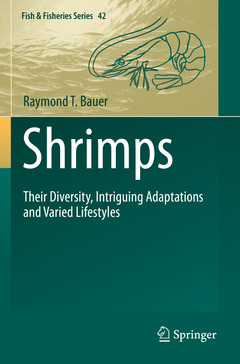Shrimps, 1st ed. 2023 Their Diversity, Intriguing Adaptations and Varied Lifestyles Fish & Fisheries Series, Vol. 42
Auteur : Bauer Raymond T.

This book explores the biology of decapod shrimps, a group of animals known to most people as a nutritious and tasty food item. Shrimps are amazingly diverse in size, shape, coloration, behavior and natural history. Shrimp fisheries and aquaculture are a vital part of the USA and world economies. These crustaceans are key ecological and food-web components of marine and freshwater habitats. The book synthesizes information on the taxonomic and ecological diversity of shrimps, the structure and function of shrimp anatomy, antifouling adaptations, coloration and camouflage, reproductive biology, sexual systems, mating systems and behavior, life history strategies, symbioses between shrimps and other organisms, shrimp fisheries and aquaculture, as well as the evolution and phylogeny of shrimps. All chapters are written within an adaptational and evolutionary perspective. Important questions about shrimp biology are asked, and hypotheses for testing in future research are proposed. The book is spiced up with personal anecdotes and observations from the author?s research experiences.
This book is intended as a comprehensive reference, a ?go to? book about the biology of shrimps. The text is scientifically rigorous but written in a style intended for a varied readership. Thus, the book is a valuable resource for budding or working research scientists such as zoologists, aquatic biologists, fisheries and aquaculture professionals, as well as amateur naturalists, aquarium hobbyists and interested laypersons. As the saying goes, ?a picture is worth a thousand words,? so that the book is amply illustrated with figures and diagrams.The numerous color plates, composed of photos contributed by expert colleagues, make the world of shrimps come alive.
Growing up in the Midwest, Dr. Bauer was always interested in the natural history of plants and animals. His science courses at the University of Missouri, Kansas City, where he received a Bachelor of Science degree, convinced him of a career in biology. He was greatly influenced by the 1960's television specials on marine biology produced by the pioneering oceanographer and co-inventor of SCUBA, Jacques Cousteau. These led him to apply for and be accepted into the graduate program at the Scripps Institution of Oceanography (University of California, San Diego), where he received a doctorate in Marine Biology in 1976. After teaching marine and invertebrate zoology courses at Cal Poly State University (San Luis Obispo), he was awarded a Postdoctoral Fellowship at the National Museum of Natural History (Smithsonian Institution). As working in tropical seas was always a dream, when he was offered a tenure-track position at the University of Puerto Rico, Río Piedras, he eagerly accepted. There he taught courses in marine science and invertebrate zoology (in Spanish) for five years (Assistant, then Associate Professor). While there, he conducted research in marine ecology and crustacean biology. He was offered and accepted a position at the University of Louisiana, Lafayette (ULL) in 1986, rising to Full Professor in 1994. He has received various awards, e.g., Fellow of the American Association for the Advancement of Science, ULL Distinguished Professor and The Crustacean Society Excellence in Research Award. He retired from ULL in 2011 with Emeritus Professor status. Since “retirement,” Dr. Bauer has continued with research, publication and teaching short courses in shrimp biology.
Presents the natural history of shrimps
Includes shrimp fisheries, aquaculture
Explores shrimp systematics, evolution
Date de parution : 04-2024
Ouvrage de 720 p.
15.5x23.5 cm
Date de parution : 04-2023
Ouvrage de 720 p.
15.5x23.5 cm
Thèmes de Shrimps :
Mots-clés :
Camouflage Coloration; Crustacean Evolution; Effect of Climate Change on Marine Organisms; Environmental Impacts on Shrimp Fisheries; Grooming Behaviour; Hermaphroditism; Invertebrate Zoology; Life History Strategies; Shrimp Aquaculture; Shrimp Fisheries; Sexual Systems; Shrimp Taxonomy; Symbiotic Shrimps



